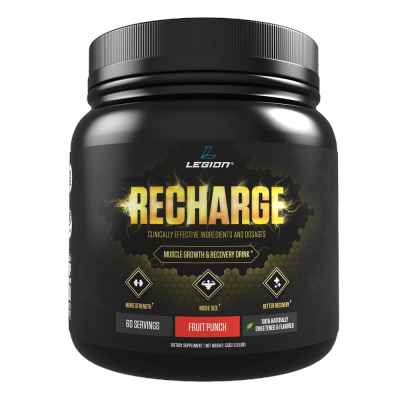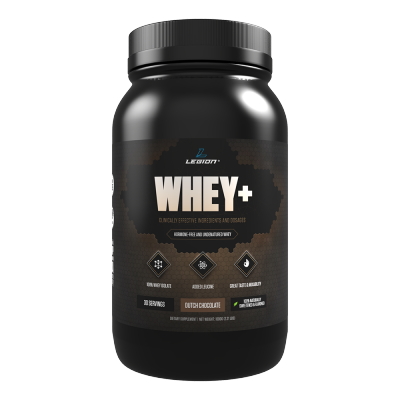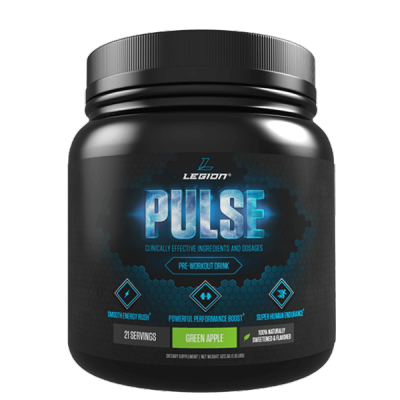Let’s face it.
The reason most of us (guys, at least) got into working out is to get an impressive upper body.
We want that armor-plated chest and sexy v-taper, and those bulging biceps, “3D” delts, and washboard abs.
If you’re looking for help with this, though, chances are you’ve found it more difficult than you expected.
I know how that goes.
I was once stuck in a rut, hopping from one workout program and supplement, to another, without much to show for it.
This went on for years, but fortunately, I finally decided to educate myself in the real science of fat loss and muscle building, and here’s where I’m at now:
And in this article, I’m going to teach you the most important things I’ve learned about building a strong, muscular upper body, and I’m going to give you an effective upper body workout that will get the needle moving right away.
I have good news, too.
Contrary to popular belief, you don’t need to live in the gym and suffer through hours and hours of grueling workouts every week to get the body you really want.
You have to work hard, yes, but it doesn’t have to take forever, and you can actually enjoy the process along the way.
So, let’s get started, shall we?
The Primary Muscles Involved in Upper Body Workouts
A good upper body workout trains several major muscle groups:
- Chest
- Back
- Shoulders
- Arms
- Core
Each of these are best trained by different exercises, and each have “special needs” if you’re going to achieve maximal development and definition.
Let’s take a minute to review them separately.
The Best Way to Train Your Chest
The muscles we’re most concerned with in our chest training are the pectoralis major and pectoralis minor.
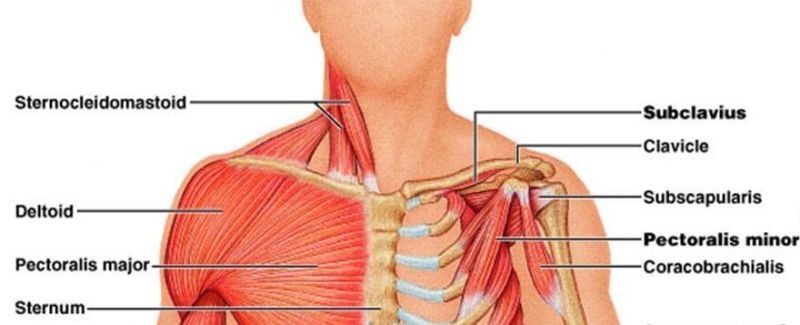
If you work on developing those two muscles, you’ll eventually get the chest you really want.
If you’re a guy, you’re also going to want to know about the “upper chest” that so many people argue about.
Some say it exists, others say it doesn’t, some say you can emphasize it in your training, others say you can’t.
Well, the truth is this:
There is an “upper chest,” but it’s not a separate muscle.
It’s just a portion of the pec major called the clavicular head, and it looks like this:
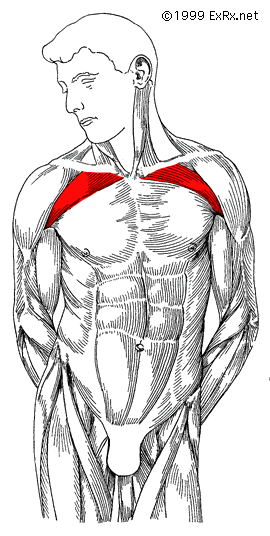
While it’s technically part of the pec major, its muscle fibers are at a different angle, which means it doesn’t respond to chest exercises in the same way as the larger portion.
This is why research shows that certain exercises, like the flat and decline bench press, emphasize the main (large) portion of the chest muscle, whereas others, like the incline and reverse-grip bench press, emphasize the smaller upper portion.
Notice that I said emphasize and not isolate.
That’s because all chest exercises that emphasize one portion of the muscle do, to some degree, involve the others.
Nevertheless, one of the most important lessons I learned about building a chest is this:
Ideal chest development requires a lot of emphasis on the clavicular head of the “upper chest.”
Fortunately, this is easy to program for because the exercises that accomplish this are also all-around effective chest exercises.
The Best Way to Train Your Back
The bulk of your back is comprised of several muscles:
- Trapezius (traps)
- Rhomboids
- Teres major and minor
- Infraspinatus
- Latissimus dorsi (lats)
- Erector spinae (iliocostalis, longissimus, and spinalis muscles)
The upper portion of your back is referred to as the thoracic spine, and it includes the trapezius, rhomboids, teres muscles, infraspinatus, and lats.
Here’s how it looks:

And the lower portion is referred to as the lumbar spine, which is mainly the erector spinae muscles shown here:
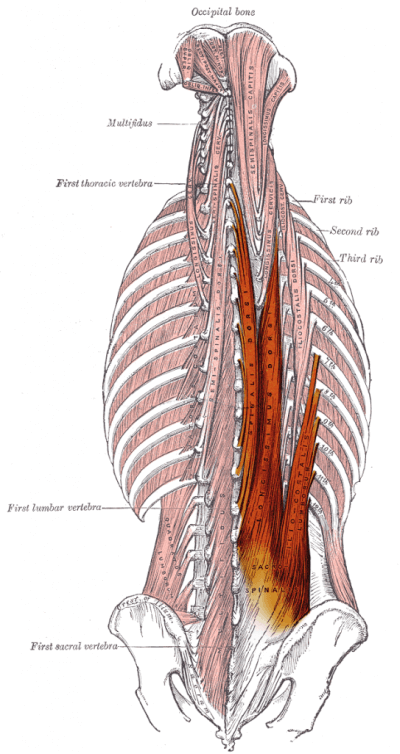
As far as back training goes, here’s the brass ring we’re striving toward:
- Well-developed traps that form the centerpiece of the upper back.
- Rhomboids that create deep “valleys” when flexed.
- Wide, long lats that give us the V-taper we all love.
- Well-developed teres and infraspinatus muscles that pop.
- Thick erector spinae that turn the lower back into a “Christmas tree.”
Here’s where I’m at with mine:
Now, people new to weightlifting tend to neglect their backs, mostly because you don’t see it in the mirror, so how important can it really be, right? 🙂
I can sympathize because I’ve been there myself (I hadn’t done a single deadlift until a few years ago), so let me assure you firsthand that this is a mistake.
Skipping your back training produces muscle imbalances that eventually look weird, and increase your risk of injury (too much pressing and too little pulling is bad news for your shoulders).
That’s why many respected weightlifting coaches recommend that you pull at least as much as you press, if not more, and why my upper body workouts always involve a good amount of back training to offset the pressing.
The Best Way to Train Your Shoulders
Your shoulders are comprised of several muscles, with the three largest being the deltoids:
- Anterior deltoid
- Lateral deltoid
- Posterior deltoid
(The rotator cuff muscles are also a part of the shoulder, but they don’t necessarily require special emphasis in your training until you’re an experienced weightlifter.)
The most important thing that you need to know about shoulder training is you have to work on developing all three deltoids, and especially the lateral and posterior muscles, because if these two are lagging, your shoulders never quite look right.
Many people think all they need for complete shoulder development is the military press, but this is rarely the case.
Overhead pressing is great for developing your anterior deltoids, but you can OHP until your arms fall off and still never get those round, “capped” delts that make jaws drop. For that, you have to include exercises specifically meant to target those muscles, like the lateral and rear delt raise.
The Best Way to Train Your Arms
As you may already know, the major arm muscles are the biceps, triceps, and forearms.
The biceps (or, technically, the biceps brachii) is a two-headed muscle that looks like this:
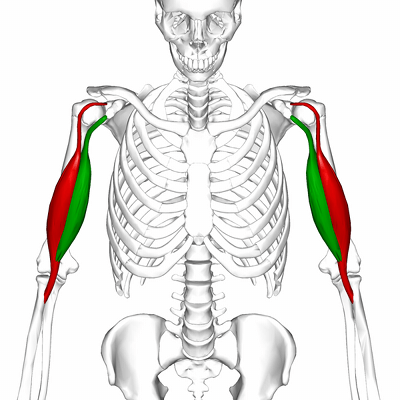
Another muscle that comes into play here is the biceps brachialis, which sits beneath the biceps brachii and helps flex the elbow.
Here’s how it looks:
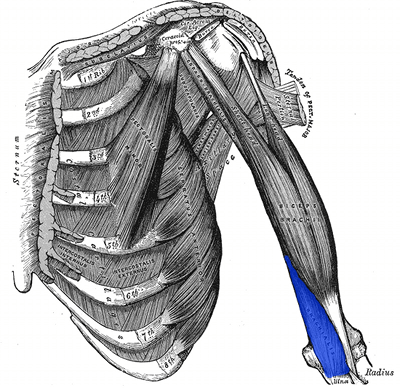
This muscle isn’t nearly as obvious as the biceps brachii, but it helps shape the overall look of your arms by propping up your “biceps speak,” and helps visually separate your biceps from the triceps.
Here’s a picture of me that I think shows this nicely:
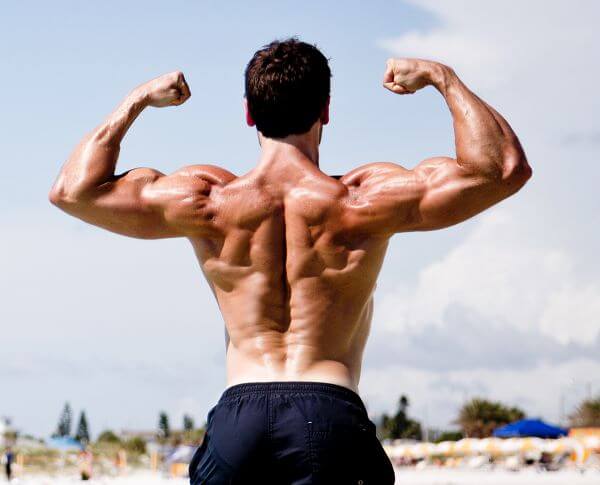
Next on the list is the unsung hero of the arms: the triceps.
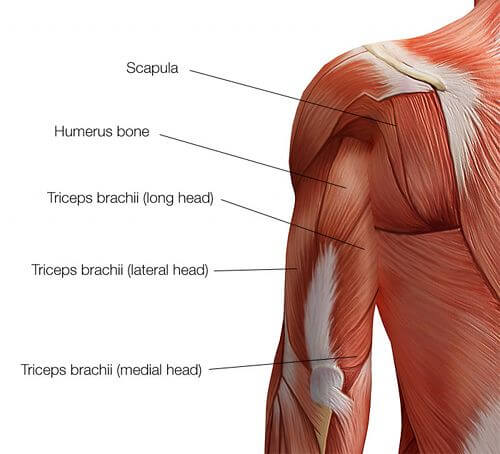
As you can see, this is a three-headed muscle that, unbeknownst to many, makes up about 2/3 of the size of your arms.
That’s right—the easiest way to add size to your arms isn’t curling, but training your triceps.
When properly developed, the three heads of this muscle form the distinctive “horseshoe” that no arms are complete without.
Finally, we have the forearms, which are comprised of several smaller muscles:

I like to think of forearms as the calves of the upper body.
They’re often ignored, and when they’re under-developed, it sticks out like a turd in a punchbowl. If they’re on point, though, you’re the envy of the gym.
That said, I’m actually not a fan of doing much in the way of forearm exercises (unless you’re looking to strengthen your grip) for two reasons:
- It’s not necessary if you’re training the rest of your upper body correctly. Your forearms will naturally develop alongside everything else.
- It can be hard on your elbows, causing joint pain and interfering with the rest of your training.
Now, many people will say that you don’t need to directly train any of your arms muscles if you’re training the rest of your upper body correctly.
That is, they say that heavy pressing alone is enough to give you great triceps, and heavy pulling is enough for great biceps
I disagree.
I’ve worked with thousands of people and I can probably count on one hand the number for whom this was true. The vast majority simply couldn’t get their arms up to snuff without targeting their biceps and triceps in their training.
So, if your arms need more inches, then you can’t afford to neglect them in your upper body workouts.
The Best Way to Train Your Core Muscles
Finally, we arrive at the showpiece: the core.
Now, if there’s one muscle group that’s identified with “fit” more than any other, it’s the abs. Everybody wants ‘em, but very few people get ‘em.
The most famous muscle of the region is the rectus abdominis, which is what we’re referring to when we talk about “abs.”

A well-developed core has more than just a well-defined rectus abdominis, though.
There are several other muscles that, when developed, complete the look, including the obliques, transverse abdominis (TVA), and serratus.
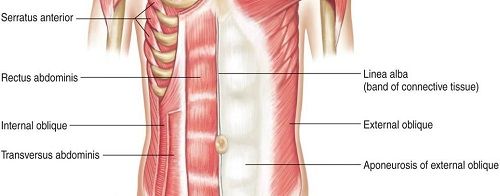
Now, the first mistake most people make in their quest for a six pack is they just don’t get lean enough.
The abs don’t become pronounced in men until around 10% body fat, and in women until around 20%, regardless of how many crunches you do.
It’s also commonly believed that ab workouts are unnecessary if you do a lot of heavy compound weightlifting.
The idea is that because exercises like the squat, deadlift, and overhead press engage the core muscles, there’s no need to train them separately.
This is mostly false.
Similar to arms, most people will find that they need to directly train their abs and core to get the cut, chiseled look they really want.
The Simple Science of Effective Upper Body Training
There are many ways to train the muscles in your upper body.
You can do bodyweight exercises, machines, or free weights. You can use lighter weights for more reps or heavier weights for fewer. You can train your upper body once, twice, or thrice per week, or even more frequently.
What’s best way?
Well, I’ve helped thousands of people of all ages and circumstances build muscle and lose fat faster than ever before, and here are the biggest lessons that I’ve learned:
1. You want to do a lot of heavy compound weightlifting.
The best types of workout programs for natural weightlifters are those that focus on heavy compound exercises like the squat, deadlift, bench press, and military press.
Sure, you can gain muscle and strength in many different ways, but decades of scientific and anecdotal evidence have conclusively proven that this is the most effective approach.
The reason heavy compound weightlifting is so powerful is simple: it’s the best way to progressively overload your muscles.
That is, it’s the best way to increase tension levels in your muscles over time, which is the primary driver of muscle growth.
This is why your number one goal in your resistance training is to increase whole-body strength, and why the strongest people in the gym are also generally the biggest.
2. You want to make sure your weekly volume is right.
By “weekly volume,” I’m referring to the total number of reps that you perform for each major muscle group each week.
If you do too little work on any muscle group, it’ll progress slower than it could, and if you do too much, you’ll eventually run into problems related to overtraining.
Now, the first thing that you should know about training volume is this:
The heavier you train, the lower your weekly volume needs to be.
The reason for this is it takes your muscles and body longer to recover from heavy weightlifting than lighter lifting. This is why popular powerlifting programs look so austere compared to the nonsense you find in most bodybuilding magazines.
The subject of optimal training volume is rather complex, but here’s what you need to know for the purposes of this article:
Research shows that when you’re using weights in the range of 60 to 85% of one-rep max, optimal volume appears to be in the range of 60 to 180 reps per major muscle group per week.
As you can guess, the lower end of this range corresponds with the heaviest weights, and the higher end with the lightest.
Now, if you’re worried that this means I’m going to ask you to do 3-hour upper body workouts a few days per week, you can breathe a sigh of relief.
Instead, I’m going to ask you to do a handful of compound exercises that train multiple major muscle groups at the same time, allowing you to rack up volume across your entire upper body much faster than you can with isolation exercises.
For example, while the bench press primarily trains the pecs and triceps, it also heavily involves the anterior deltoids, which means you don’t need to do as much direct shoulder training to give them the volume they need to grow bigger and stronger.
Alright, so now that we’ve covered our fundamental training philosophy for our upper body workouts, let’s talk exercises.
The Best Upper Body Exercises
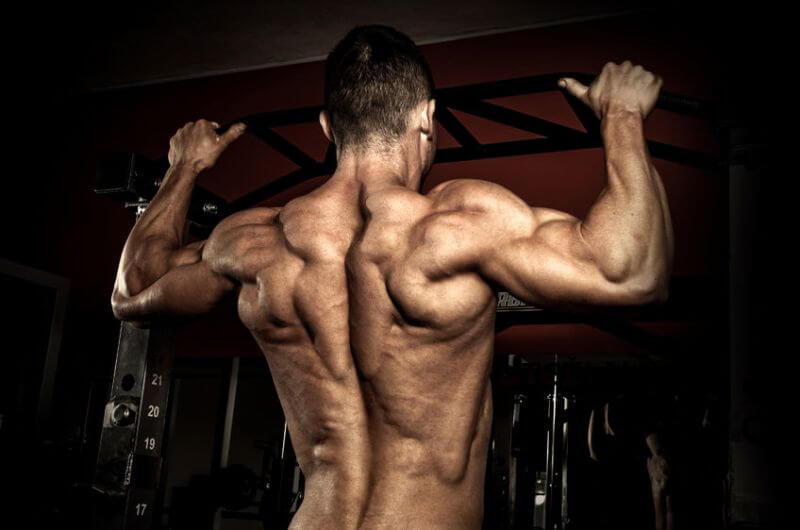
There are literally thousands of upper body exercises to choose from, and just as many opinions as to which are good and which aren’t.
Sorting and weighing them can be damn near impossible without help, so that’s what I’m going to do here for you.
Below you’ll find a list of the most effective upper body exercises that you can do (with links to videos on how to do each).
You don’t have to do these exercises and only these for the rest of your life, but they’re all you really need to build the upper body of your dreams.
The Best Chest Exercises
- Barbell Bench Press
- Flat
- Incline
- Close-Grip Bench Press
- Reverse-Grip Bench Press
- Dumbbell Bench Press
- Flat
- Incline
- Dip
The Best Back Exercises
- Deadlift
- Conventional Deadlift
- Hex Bar Deadlift
- Sumo Deadlift
- Barbell Row
- Dumbbell Row
- T-Bar Row
- Pull-up
- Chin-up
- Lat Pulldown (Wide- and Close-Grip)
- Seated Cable Row (Wide- and Close-Grip)
The Best Shoulders Exercises
- Seated or Standing Military Press
- Arnold Press
- Dumbbell Front Raise
- Dumbbell Side Lateral Raise
- Dumbbell Rear Lateral Raise
- Barbell Rear Delt Row
- Cable Face Pull
The Best Biceps Exercises
The Best Triceps Exercises
The Best Core Exercises
That’s it.
If you make it your mission to master those movements, your upper body will never be the same again.
Now, you’ve probably noticed that there isn’t much in the way of cable work, machines, or bodyweight exercises.
The reason for this is while those exercises do have a place in some people’s training (experienced bodybuilders, for example), free weight exercises are going to serve your needs better.
The Ultimate Upper Body Workout

Alright, we’re finally ready to get into the gym, and put some plates on the bar.
So, here’s what I want you to do twice per week, with a couple days of rest in between each workout (Mondays and Thursdays, for example):
Bench Press
Warm up and 2 sets of 4 to 6 reps (80 to 85% of 1RM)
Close-Grip Bench Press
2 sets of 4 to 6 reps
Standing Military Press
Warm up and 2 sets of 4 to 6 reps
Dumbbell Lateral Raise
2 sets of 8 to 10 reps (75% of 1RM)
Barbell Row
Warm up and 2 sets of 4 to 6 reps
Lat Pulldown
2 sets of 4 to 6 reps
Dumbbell Curl
2 sets of 4 to 6 reps
Cable Crunch
3 sets of 8 to 10 reps
That’s a tough workout, but it shouldn’t take you more than 75 to 90 minutes, and it will hit every muscle in your upper body.
There are a few other things that you should know to get the most out of it:
1. Once you hit the top of your rep range for one set, you move up in weight.
For instance, if push out 6 reps on your first set of the military press, you add 5 pounds to each side of the bar for your next set and work with that weight until you can press it for 6 reps, and so forth.
2. Rest 3 minutes in between each 4-to-6-rep set, 2 minutes in between 6-to-8-rep sets, and 1 minute in between 8-to-10-rep sets.
Getting adequate rest in between sets is important because it allows your muscles to fully recoup their strength so you can give maximum effort each set.
3. Make sure you’re eating enough food.
Most people know that high protein intake is necessary to maximize muscle growth but don’t know that caloric intake also plays a major role.
You can learn more about this here.
Oh and FYI, this type of training is the core of my Bigger Leaner Stronger (for men) and Thinner Leaner Stronger (for women) programs, and I have hundreds of success stories that prove its effectiveness.
If you give this workout a go and like it, I highly recommend you check out BLS/TLS because you’re going to love it.
Happy training!
What About Supplements?
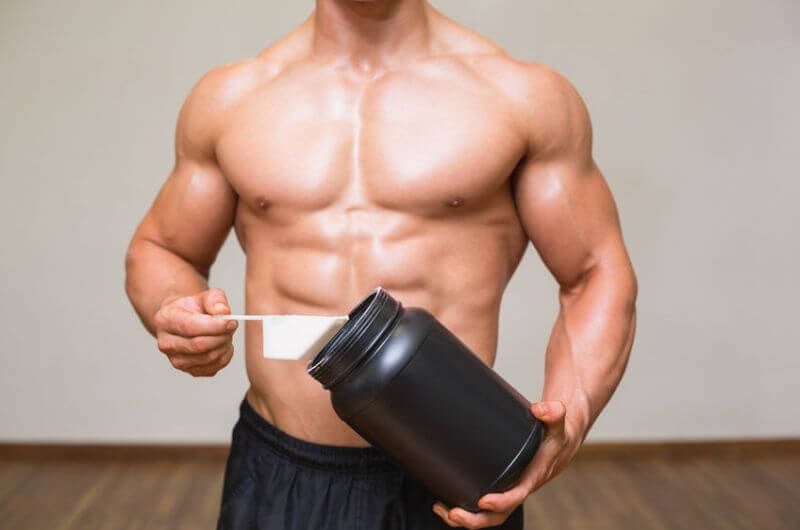
I saved this for last because, quite frankly, it’s far less important than proper diet and training.
You see, supplements don’t build great physiques–dedication to proper training and nutrition does.
Unfortunately, the workout supplement industry is plagued by pseudoscience, ridiculous hype, misleading advertising and endorsements, products full of junk ingredients, underdosing key ingredients, and many other shenanigans.
Most supplement companies produce cheap, junk products and try to dazzle you with ridiculous marketing claims, high-profile (and very expensive) endorsements, pseudo-scientific babble, fancy-sounding proprietary blends, and flashy packaging.
So, while workout supplements don’t play a vital role in building muscle and losing fat, and many are a complete waste of money…the right ones can help.
The truth of the matter is there are safe, natural substances that have been scientifically proven to deliver benefits such as increased strength, muscle endurance and growth, fat loss, and more.
As a part of my work, it’s been my job to know what these substances are, and find products with them that I can use myself and recommend to others.
Finding high-quality, effective, and fairly priced products has always been a struggle, though.
That’s why I took matters into my own hands and decided to create my own supplements. And not just another line of “me too” supplements–the exact formulations I myself have always wanted and wished others would create.
I won’t go into a whole spiel here, but if you want to learn more about my supplement line, check this out. (And if you’d like to know exactly what supplements to take to reach your fitness goals, take the Legion Supplement Finder Quiz.)
For the purpose of this article, let’s just quickly review the supplements that are going to help you get the most out of your upper body (and other) workouts.
Creatine
Creatine is a substance found naturally in the body and in foods like red meat. It’s perhaps the most researched molecule in the world of sport supplements–the subject of hundreds of studies–and the consensus is very clear:
Supplementation with creatine helps…
You may have heard that creatine is bad for your kidneys, but these claims have been categorically and repeatedly disproven. In healthy subjects, creatine has been shown to have no harmful side effects, in both short- or long-term usage. People with kidney disease are not advised to supplement with creatine, however.
If you have healthy kidneys, I highly recommend that you supplement with creatine. It’s safe, cheap, and effective.
In terms of specific products, I use my own, of course, which is called RECHARGE.
RECHARGE is 100% naturally sweetened and flavored and each serving contains:
- 5 grams of creatine monohydrate
- 2100 milligrams of L-carnitine L-tartrate
- 10.8 milligrams of corosolic acid
This gives you the proven strength, size, and recovery benefits of creatine monohydrate plus the muscle repair and insulin sensitivity benefits of L-carnitine L-tartrate and corosolic acid.
Protein Powder
You don’t need protein supplements to gain muscle, but, considering how much protein you need to eat every day to maximize muscle growth, getting all your protein from whole food can be impractical.
That’s the main reason I created (and use) a whey protein supplement. (There’s also evidence that whey protein is particularly good for your post-workout nutrition.)
WHEY+ is 100% naturally sweetened and flavored whey isolate that is made from milk sourced from small dairy farms in Ireland, which are known for their exceptionally high-quality dairy.
I can confidently say that this is the creamiest, tastiest, healthiest all-natural whey protein powder you can find.
Pre-Workout Drink
There’s no question that a pre-workout supplement can get you fired up to get to work in the gym. There are downsides and potential risks, however.
Many pre-workout drinks are stuffed full of ineffective ingredients and/or minuscule dosages of otherwise good ingredients, making them little more than a few cheap stimulants with some “pixie dust” sprinkled in to make for a pretty label and convincing ad copy.
Many others don’t even have stimulants going for them and are just complete duds.
Others still are downright dangerous, like USPLabs’ popular pre-workout “Jack3d,”which contained a powerful (and now banned) stimulant known as DMAA.
Even worse was the popular pre-workout supplement “Craze,” which contained a chemical similar to methamphetamine.
The reality is it’s very hard to find a pre-workout supplement that’s light on stimulants but heavy on natural, safe, performance-enhancing ingredients like beta-alanine, betaine, and citrulline.
And that’s why I made my own pre-workout supplement. It’s called PULSE and it contains 6 of the most effective performance-enhancing ingredients available:
- Caffeine. Caffeine is good for more than the energy boost. It also increases muscle endurance and strength.
- Beta-Alanine. Beta-alanine is a naturally occurring amino acid that reduces exercise-induced fatigue, improves anaerobic exercise capacity, and can accelerate muscle growth.
- Citrulline Malate. Citrulline is an amino acid that improves muscle endurance, relieves muscle soreness, and improves aerobic performance.
- Betaine. Betaine is a compound found in plants like beets that improves muscle endurance, increases strength, and increases human growth hormone and insulin-like growth factor 1 production in response to acute exercise.
- Ornithine. Ornithine is an amino acid found in high amounts in dairy and meat that reduces fatigue in prolonged exercise and promotes lipid oxidation (the burning of fat for energy as opposed to carbohydrate or glycogen).
- Theanine. Theanine is an amino acid found primarily in tea that reduces the effects of mental and physical stress, increases the production of nitric oxide, which improves blood flow, and improves alertness, focus, attention, memory, mental task performance, and mood.
And what you won’t find in PULSE is equally special:
- No artificial sweeteners or flavors..
- No artificial food dyes.
- No unnecessary fillers, carbohydrate powders, or junk ingredients.
The bottom line is if you want to know what a pre-workout is supposed to feel like…if you want to experience the type of energy rush and performance boost that only clinically effective dosages of scientifically validated ingredients can deliver…then you want to try PULSE.
Again, if you feel confused about what supplements you should take to reach your goals, take the Legion Supplement Finder Quiz to learn exactly what supplements are right for you. It’s the best way to ensure you get the most out of your supplement regimen.
The Bottom Line on Upper Body Workouts
If you follow the advice in this article, you’ll have no trouble gaining significant amounts of upper body muscle and strength.
And especially if you’re new to this style of working out (your body will be hyper-responsive to it).
So, do your upper body workouts, push yourself to get stronger in each of the exercises, eat right, and take the right supplements, and your upper body will transform before your very eyes.
Happy training!
What’s your take on upper body workouts? Do you have anything else to add? Let me know in the comments below!
Scientific References +
- Willardson JM. A brief review: Factors affecting the length of the rest interval between resistance exercise sets. J Strength Cond Res. 2006;20(4):978-984. doi:10.1519/R-17995.1
- Peterson MD, Rhea MR, Alvar BA. Applications of the dose-response for muscular strength development: A review of meta-analytic efficacy and reliability for designing training prescription. In: Journal of Strength and Conditioning Research. Vol 19. ; 2005:950-958. doi:10.1519/R-16874.1
- Wernbom M, Augustsson J, Thomeé R. The influence of frequency, intensity, volume and mode of strength training on whole muscle cross-sectional area in humans. Sport Med. 2007;37(3):225-264. doi:10.2165/00007256-200737030-00004
- Goldberg AL, Etlinger JD, Coldspink DF, Jableck C. Mechanism of work-induced hypertrophy of skeletal muscle. Med Sci Sports. 1975;7(4):248-261. doi:10.1249/00005768-197500740-00003
- Trebs AA, Brandenburg JP, Pitney WA. An electromyography analysis of 3 muscles surrounding the shoulder joint during the performance of a chest press exercise at several angles. J Strength Cond Res. 2010;24(7):1925-1930. doi:10.1519/JSC.0b013e3181ddfae7
